Spatiotemporal Variation Characteristics of Extreme Precipitation in the Mid–Lower Reaches of the Yangtze River Basin Based on Precipitation Events
Abstract
1. Introduction
1.1. Impact of Climate Change on Extreme Precipitation
1.2. Research Perspective on the Time Process of Extreme Precipitation Event
2. Materials and Methods
2.1. Study Area
2.2. Data Sources
2.3. Data Analysis
2.3.1. Extreme Precipitation Indices
2.3.2. Definition and Classification of EPEs
2.3.3. Analysis Methods
- (1)
- Trend Analysis
- (2)
- ANUSPLIN Spatial Interpolation
- (3)
- Cross-Wavelet Analysis
- (4)
- Estimation of EPE Return Level
3. Results
3.1. Spatiotemporal Variation of Extreme Precipitation
3.1.1. Variations in Temporal and Spatial Extreme Precipitation
3.1.2. Variations in the Trends in Extreme Precipitation Indices
3.2. Variation Characteristics of EPE Types
3.2.1. Annual Distribution of EPEs
3.2.2. Dominant Types of EPEs
3.2.3. Interannual Variations in EPE
Trends of Different EPE Types
Significance of Variations in EPE Trends
Impact and Contribution of Extreme Precipitation to EPE
3.2.4. Return Levels of Precipitation for EPEs
3.2.5. Responses of EPE Types to Regional Warming
4. Discussion
4.1. Areas at High Risk of EPEs Under Climate Change in the MLRYRB
4.2. Rationality of the EPE Concept for Application in the MLRYRB
5. Conclusions
Author Contributions
Funding
Institutional Review Board Statement
Informed Consent Statement
Data Availability Statement
Conflicts of Interest
References
- Trenberth, K.E. Changes in Precipitation with Climate Change. Clim. Res. 2011, 47, 123–138. [Google Scholar] [CrossRef]
- Fowler, H.J.; Lenderink, G.; Prein, A.F.; Westra, S.; Allan, R.P.; Ban, N.; Barbero, R.; Berg, P.; Blenkinsop, S.; Do, H.X.; et al. Anthropogenic intensification of short-duration rainfall extremes. Nat. Rev. Earth Environ. 2021, 2, 107–122. [Google Scholar] [CrossRef]
- Zhang, J.G.; Li, C.X.; Zhang, X.B.; Zhao, T.B. Improving simulations of extreme precipitation events in China by the CMIP6 global climate models through statistical downscaling. Atmos. Res. 2024, 303, 107344. [Google Scholar] [CrossRef]
- Frich, P.; Alexander, L.V.; Della-Marta, P.; Gleason, B.; Haylock, M.; Tank, A.M.G.K.; Peterson, T. Observed coherent changes in climatic extremes during the second half of the twentieth century. Clim. Res. 2002, 19, 193–212. Available online: https://www.jstor.org/stable/24866781 (accessed on 30 January 2023). [CrossRef]
- Alexander, L.V.; Zhang, X.; Peterson, T.C.; Caesar, J.; Gleason, B.E.; Tank, A.M.; Haylock, M.R.; Collins, D.; Trewin, B.C.; Rahimzadeh, F.; et al. Global observed changes in daily climate extremes of temperature and precipitation. J. Geophys. Res. 2006, 111, 1042–1063. [Google Scholar] [CrossRef]
- Chen, F.H.; Wang, J.S.; Jin, L.; Zhang, Q.; Li, J.; Chen, J.H. Rapid warming in mid-latitude central Asia for the past 100 years. Front. Earth Sci. 2009, 3, 42–50. [Google Scholar] [CrossRef]
- Ren, X.; Sha, Y.; Shi, Z.; Liu, X. Response of summer extreme precipitation over East Asia during the mid-Holocene versus future global warming. Glob. Planet. Change 2021, 197, 103398. [Google Scholar] [CrossRef]
- Sun, T.L.; Yao, S.X.; Huang, Q.; Guo, Q.; Xia, Y.C.; Zhang, H.M. Possible mechanism of the mid-high-latitude synoptic-scale disturbances impact on Meiyu precipitation anomalies. Atmos. Res. 2024, 298, 107137. [Google Scholar] [CrossRef]
- Shi, Y.F.; Jiang, T.Q.; Su, B.D.; Chen, J.Q.; Qin, N.X. Preliminary analysis on the relation between the evolution of heavy floods in the Yangtze River catchment and the climate changes since 1840. J. Lake Sci. 2004, 16, 289–297. (In Chinese) [Google Scholar] [CrossRef]
- Chen, J.Q.; Shi, Y.F.; Zhang, Q.; Zhang, Z.X. Climatic background for historical flood of 1860, 1870 during past 500 years in the upper Yangtze River basin. J. Lake Sci. 2006, 18, 476–483. (In Chinese) [Google Scholar] [CrossRef]
- Xu, Y.T.; Fang, J.; Tao, K.; Fang, J.Y.; Liu, Y.X. Increasing risk of synchronous floods in the Yangtze River basin from the shift in flood timing. Sci. Total Environ. 2024, 921, 171167. [Google Scholar] [CrossRef] [PubMed]
- Gao, T.; Xie, L. Spatiotemporal changes in precipitation extremes over Yangtze River Basin, China, considering the rainfall shift in the late 1970s. Glob. Planet. Chang. 2016, 147, 106–124. [Google Scholar] [CrossRef]
- Yuan, Z.; Yin, J.; Wei, M.; Yuan, Y. Spatio-temporal variations in the temperature and precipitation extremes in Yangtze River basin, China during 1961–2020. Atmosphere 2021, 12, 1423. [Google Scholar] [CrossRef]
- Jiang, Y.; He, X.G.; Li, J.J.; Zhang, X.P. On the response of daily precipitation extremes to local mean temperature in the Yangtze River basin. Atmos. Res. 2024, 300, 107265. [Google Scholar] [CrossRef]
- Zhang, S.; Ren, G.F.; Zhan, Y.J.; Zhang, C.; Ren, Y.Y. Extreme precipitation changes over the Yangtze River Basin in 1901–2020. Clim. Res. 2023, 90, 59–76. [Google Scholar] [CrossRef]
- Zhang, Q.; Peng, J.T.; Xu, C.Y.; Singh, V.P. Spatiotemporal variations of precipitation regimes across Yangtze River Basin, China. Theor. Appl. Climatol. 2014, 115, 703–712. [Google Scholar] [CrossRef]
- Gong, L.; Zhang, X.; Liu, J.; Gui, H.J. Exploring the influence of urban agglomeration on extreme precipitation: Evidence from the middle reaches of the Yangtze River, China. J. Hydrol. Reg. Stud. 2024, 55, 101932. [Google Scholar] [CrossRef]
- Wu, X.; Guo, S.; Yin, J.; Yang, G.; Zhong, Y.; Liu, D. On the event-based extreme precipitation across China: Time distribution patterns, trends, and return levels. J. Hydrol. 2018, 562, 305–317. [Google Scholar] [CrossRef]
- She, D.X.; Shao, Q.X.; Xia, J.; Taylor, J.A.; Zhang, Y.Y.; Zhang, L.P.; Zhang, X.; Zou, L. Investigating the variation and non-stationarity in precipitation extremes based on the concept of event-based extreme precipitation. J. Hydrol. 2015, 530, 785–798. [Google Scholar] [CrossRef]
- Zaman, M.; Ahmad, I.; Usman, M.; Saifullah, M.; Anjum, M.N.; Khan, M.I.; Uzair Qamar, M. Event-based time distribution patterns, return levels, and their trends of extreme precipitation across Indus basin. Water 2020, 12, 3373. [Google Scholar] [CrossRef]
- Li, S.S.; Wang, C.B.; Yan, J.P.; Liu, X.F. Variability of the event-based extreme precipitation in the south and north Qinling Mountains. Acta Geogr. Sin. 2020, 75, 989–1007. (In Chinese) [Google Scholar] [CrossRef]
- Malla, M.K.; Arya, D.S. Event-based extreme precipitation variability analysis over a part of the Hindu Kush Himalayan region. Int. J. Climatol. 2023, 43, 4196–4219. [Google Scholar] [CrossRef]
- White, R.H.; Battisti, D.S.; Skok, G. Tracking precipitation events in time and space in gridded observational data. Geophys. Res. Lett. 2017, 44, 8637–8646. [Google Scholar] [CrossRef]
- Hellie, F.; Peschke, G.; Seidler, C.; Niedel, D. Process-oriented subdivision of basins to improve the preprocessing of distributed precipitation-runoff-models. Interdiscip. Approaches Small Catchment Hydrol. Monit. Res. 2002, 137. Available online: https://www.researchgate.net/publication/242218175_Process-oriented_subdivision_of_basins_to_improve_the_preprocessing_of_distributed_precipitation-runoff-models (accessed on 25 February 2023).
- Wang, X.E.; Luo, M.; Wu, S.; Ning, G.; Liu, Z.; Wang, S.; Wang, P.; Zhang, H.; Li, X. Spatiotemporal evolution patterns of contiguous extreme precipitation events across China from a 3D perspective. Geophys. Res. Lett. 2022, 49, e2022GL098840. [Google Scholar] [CrossRef]
- Zhang, Y.H.; Liang, K.; Liu, C.M. Time distribution pattern and spatial heterogeneity of hourly scale event-based extreme precipitation in China. J. Hydrol. 2023, 622, 129712. [Google Scholar] [CrossRef]
- Guan, Y.H.; Zheng, F.L.; Zhang, X.C.; Wang, B. Trends and variability of daily precipitation and extremes during 1960–2012 in the Yangtze River Basin, China. Int. J. Climatol. 2017, 37, 1282–1298. [Google Scholar] [CrossRef]
- Lü, M.Q.; Wu, S.J.; Chen, J.L.; Chen, C.D.; Wen, Z.F.; Huang, Y.Y. Changes in extreme precipitation in the Yangtze River basin and its association with global mean temperature and ENSO. Int. J. Climatol. 2018, 38, 1989–2005. [Google Scholar] [CrossRef]
- Li, X.; Zhang, K.; Gu, P.R.; Feng, H.T.; Yin, Y.F.; Cheng, W.; Cheng, B.C. Changes in precipitation extremes in the Yangtze River basin during 1960-2019 and the association with global warming, ENSO, and local effects. Sci. Total Environ. 2021, 760, 144244. [Google Scholar] [CrossRef]
- Wu, X.; Wang, L.; Niu, Z.; Jiang, W.; Cao, Q. More extreme precipitation over the Yangtze River Basin, China: Insights from historical and projected perspectives. Atmos. Res. 2023, 292, 106883. [Google Scholar] [CrossRef]
- Vittal, H.; Karmakar, S.; Ghosh, S. Diametric changes in trends and patterns of extreme rainfall over India from pre-1950 to post-1950. Geophys. Res. Lett. 2013, 40, 3253–3258. [Google Scholar] [CrossRef]
- Garambois, P.A.; Larnier, K.; Roux, H.; Labat, D.; Dartus, D. Analysis of flash flood-triggering rainfall for a process-oriented hydrological model. Atmos. Res. 2014, 137, 14–24. [Google Scholar] [CrossRef]
- Xiao, C.; Wu, P.; Zhang, L.; Song, L.C. Robust increase in extreme summer rainfall intensity during the past four decades observed in China. Sci. Rep. 2016, 6, 38506. [Google Scholar] [CrossRef] [PubMed]
- Norbiato, D.; Borga, M.; Esposti, S.D.; Gaume, E.; Anquetin, S. Flash flood warning based on rainfall thresholds and soil moisture conditions: An assessment for gauged and ungauged basins. J. Hydrol. 2008, 362, 274–290. [Google Scholar] [CrossRef]
- Montesarchio, V.; Ridolfi, E.; Russo, F.; Napolitano, F. Rainfall threshold definition using an entropy decision approach and radar data. Nat. Hazards Earth Syst. Sci. 2011, 11, 2061–2074. [Google Scholar] [CrossRef]
- Coelho, G.D.A.; Ferreira, C.M.; Kinter, J.L. III. Multiscale and multi event evaluation of short-range real-time flood forecasting in large metropolitan areas. J. Hydrol. 2022, 612, 128212. [Google Scholar] [CrossRef]
- Yin, H.F.; Li, C.G. Human impact on floods and flood disasters on the Yangtze River. Geomorphology 2001, 41, 105–109. [Google Scholar] [CrossRef]
- Lu, H.; Shao, Q.; Liu, J.; Wang, J.; Chen, Z. Temporo-spatial distribution of summer precipitationover Qinghai-Tibet Plateau during the last 44 years. Acta Geogr. Sin. 2007, 62, 946–958. (In Chinese) [Google Scholar] [CrossRef]
- Yuan, C.; Yang, M. Interannual variations in summer precipitation in southwest China: Anomalies in moisture transport and the role of the tropical Atlantic. J. Clim. 2020, 33, 5993–6007. [Google Scholar] [CrossRef]
- Lu, G.; Li, Q.Q.; Sun, X.T.; Zhao, M.C.; Dong, L.L.; Wu, Q.Y.; Wang, L.J.; Zhao, L.; Duan, C.F.; Yin, Y.Z.; et al. Comparative analysis of peak-summer heatwaves in the Yangtze-Huaihe River Basin of China in 2022 and 2013: Thermal effects of the Tibetan Plateau. Atmos. Res. 2024, 300, 107222. [Google Scholar] [CrossRef]
- Nanding, N.; Chen, Y.; Wu, H.; Dong, B.; Tian, F.; Lott, F.C.; Tett, S.F.B.; Rico-Ramirez, M.A.; Chen, Y.; Huang, Z.; et al. Anthropogenic Influences on 2019 July Precipitation Extremes Over the Mid-Lower Reaches of the Yangtze River. Front. Environ. Sci. 2020, 8, 603061. [Google Scholar] [CrossRef]
- Zhang, X.; Alexander, L.; Hegerl, G.C.; Jones, P.; Tank, A.K.; Peterson, T.C.; Trewin, B.; Zwiers, F.W. Indices for monitoring changes in extremes based on daily temperature and precipitation data. Wiley Interdiscip. Rev. Clim. Chang. 2011, 2, 851–870. [Google Scholar] [CrossRef]
- Agyekum, J.; Annor, T.; Quansah, E.; Lamptey, B.; Okafor, G. Extreme temperature indices over the Volta Basin: CMIP6 model evaluation. Sci. Afr. 2022, 16, e01181. [Google Scholar] [CrossRef]
- Topaloğlu, F. Regional trend detection of Turkish river flows. Hydrol. Res. 2006, 37, 165–182. [Google Scholar] [CrossRef]
- Hamed, K.H.; Rao, A.R. A modified Mann-Kendall trend test for autocorrelated data. J. Hydrol. 1998, 204, 182–196. [Google Scholar] [CrossRef]
- Kendall, M.; Jean, G. Rank Correlation Methods. Br. J. Psychol. 1990, 25, 86–91. [Google Scholar] [CrossRef]
- Bonaccorso, B.; Cancelliere, A.; Rossi, G. Detecting trends of extreme rainfall series in Sicily. Adv. Geosci. 2005, 2, 7–11. [Google Scholar] [CrossRef]
- Hutchinson, M.F.; McKenney, D.W.; Lawrence, K.; Pedlar, J.H.; Hopkinson, R.F.; Milewska, E.; Papadopol, P. Development and testing of Canada-Wide Interpolated spatial models of daily minimum-maximum temperature and precipitation for 1961–2003. J. Appl. Meteorol. Climatol. 2009, 48, 725–741. [Google Scholar] [CrossRef]
- Whitcher, B.; Guttorp, P.; Percival, D.B. Wavelet analysis of covariance with application to atmospheric time series. J. Geophys. Res. Atmos. 2000, 105, 14941–14962. [Google Scholar] [CrossRef]
- Grinsted, A.; Moore, J.C.; Jevrejeva, S. Application of the cross wavelet transform and wavelet coherence to geophysical time series. Nonlinear Process. Geophys. 2004, 11, 561–566. [Google Scholar] [CrossRef]
- Wu, X.; Wang, Z.; Guo, S.; Liao, W.; Zeng, Z.; Chen, X. Scenario-based projections of future urban inundation within a coupled hydrodynamic model framework: A case study in Dongguan City, China. J. Hydrol. 2017, 547, 428–442. [Google Scholar] [CrossRef]
- Su, H.; Hu, J.; Wen, Z. Service life predicting of dam systems with correlated failure modes. J. Perform. Constr. Facil. 2011, 27, 252–269. [Google Scholar] [CrossRef]
- Kuzuha, Y. Estimating optimal stochastic probability distributions of daily precipitation considering return periods of the largest records. J. Jpn. Soc. Hydrol. Water Resour. 2015, 28, 59–71. [Google Scholar] [CrossRef]
- Ding, Y.; Zhang, J.; Jiang, Z. Experimental simulations of extreme precipitation based on the multi-status markov chain model. Acta Meteorol. Sin. 2010, 24, 484–491. [Google Scholar] [CrossRef]
- Langousis, A.; Mamalakis, A.; Puliga, M.; Deidda, R. Threshold detection for the generalized Pareto distribution: Review of representative methods and application to the NOAA NCDC daily rainfall database. Water Resour. Res. 2016, 52, 2659–2681. [Google Scholar] [CrossRef]
- Donegan, S.P.; Tucker, J.C.; Rollett, A.D.; Barmak, K.; Groeber, M. Extreme value analysis of tail departure from log-normality in experimental and simulated grain size distributions. Acta Mater. 2013, 61, 5595–5604. [Google Scholar] [CrossRef]
- Pels, W.A.; Adebanji, A.O.; Twumasi-Ankrah, S. Comparison of parameter estimators for Generalized Pareto Distribution under peak over threshold. Math. Stat. 2020, 8, 711–720. [Google Scholar] [CrossRef]
- Gründemann, G.J.; Giesen, N.V.D.; Brunner, L.; Ent, R.V.D. Rarest rainfall events will see the greatest relative increase in magnitude under future climate change. Commun. Earth Environ. 2022, 3, 235. [Google Scholar] [CrossRef]
- Gao, J.J.; Ma, P.F.; Du, J.; Huang, X.Q. Spatial distribution of extreme precipitation in the Tibetan Plateau and effects of external forcing factors based on Generalized Pareto Distribution. Water Supply 2021, 21, 1253–1262. [Google Scholar] [CrossRef]
- Simmonds, I.; Bi, D.H.; Yan, B.L. Relationships between summer rainfall over China and ocean temperatures in the tropical western pacific. J. Meteorol. Soc. Jpn. 1996, 74, 273–279. [Google Scholar] [CrossRef]
- Chen, X.; Zhou, T. Relative contributions of external SST forcing and internal atmospheric variability to July-August heat waves over the Yangtze River valley. Clim. Dyn. 2018, 51, 4403–4419. [Google Scholar] [CrossRef]
- Gao, M.; Wang, B.; Yang, J.; Dong, W. Are peak summer sultry heat wave days over the Yangtze-Huaihe River Basin predictable? J. Clim. 2018, 31, 2185–2196. [Google Scholar] [CrossRef]
- Deng, K.Q.; Jiang, X.W.; Hu, C.D.; Chen, D.L. More frequent summer heat waves in southwestern China linked to the recent declining of Arctic sea ice. Environ. Res. Lett. 2020, 15, 074011. [Google Scholar] [CrossRef]
- Miller, N.L.; Jin, J.; Tsang, C.F. Local climate sensitivity of the Three Gorges Dam. Geophys. Res. Lett. 2005, 32, L16704. [Google Scholar] [CrossRef]
- Ma, Z.Z.; Ray, R.L.; He, Y.P. Assessing the spatiotemporal distributions of evapotranspiration in the Three Gorges Reservoir Region of China using remote sensing data. J. Mt. Sci. 2018, 15, 2676–2692. [Google Scholar] [CrossRef]
- Huang, S.Z.; Zhang, X.; Chen, N.C.; Li, B.Y.; Ma, H.L.; Xu, L.; Li, R.H.; Dev, N. Drought propagation modification after the construction of the Three Gorges Dam in the Yangtze River Basin. J. Hydrol. 2021, 603, 127138. [Google Scholar] [CrossRef]
- Liu, J.Q.; Lin, C.; Dong, S.; Feng, R.X.; Su, A.; Cui, J.H.; Yu, S.P. 30 Years of Climate Change before and after the Impoundment of the Three Gorges Reservoir. J. Earth Sci. 2023, 34, 1315–1318. [Google Scholar] [CrossRef]
- Liu, X.B.; Peng, J.; Liu, Y.X.; Yu, S.T.; Wang, Y.L. The Three Gorges Dam has weakened the drought propagation process in the Yangtze River Basin. J. Hydrol. 2024, 632, 130875. [Google Scholar] [CrossRef]
- Dong, Q.; Zhang, X.; Lall, U.; Sang, Y.F.; Xie, P. An improved nonstationary model for flood frequency analysis and its implication for the three gorges dam China. Hydrol. Sci. J. 2019, 64, 845–855. [Google Scholar] [CrossRef]
- Tang, H.M.; Wasowski, J.; Juang, C.H. Geohazards in the Three Gorges Reservoir Area, China-Lessons learned from decades of research. Eng. Geol. 2019, 261, 105267. [Google Scholar] [CrossRef]
- Sheng, L.; Liu, D.Y.; Wang, B.H.; Yu, S.H.; Zuo, Y.W.; Gu, F.T. Temporal variations characteristic of precipitation in the Three Gorges Reservoir Area from 1961 to 2016. J. Water Clim. Chang. 2022, 13, 1765–1775. [Google Scholar] [CrossRef]
- Wu, X.J.; Wang, L.C.; Cao, Q.; Niu, Z.G.; Dai, X. Regional climate change and possible causes over the Three Gorges Reservoir Area. Sci. Total Environ. 2023, 903, 166263. [Google Scholar] [CrossRef] [PubMed]
- Zhang, Y.X.; Li, P.; Xu, G.C.; Min, Z.Q.; Li, Q.S.; Li, Z.B.; Wang, B.; Chen, Y.T. Temporal and spatial variation characteristics of extreme precipitation on the Loess Plateau of China facing the precipitation process. J. Arid Land 2023, 15, 439–459. [Google Scholar] [CrossRef]
- Melching, C.S.; Papanicolaou, A.N. Foreword to the Special Issue on the Yangtze River. J. Hydraul. Eng. 2009, 135, 697. [Google Scholar] [CrossRef]
- Jia, H.C.; Chen, F.; Pan, D.H.; Du, E.Y.; Wang, L.; Wang, N.; Yang, A.Q. Flood risk management in the Yangtze River basin-Comparison of 1998 and 2020 events. Int. J. Disaster Risk Reduct. 2021, 68, 102724. [Google Scholar] [CrossRef]
- Cascini, L.; Cuomo, S.; Pastor, M.; Sacco, C. Modelling the post-failure stage of rainfall-induced landslides of the flow type. Can. Geotech. J. 2013, 50, 924–934. [Google Scholar] [CrossRef]
- Wang, K.; Zhang, S. Rainfall-induced landslides assessment in the Fengjie County, Three-Gorge reservoir area, China. Nat. Hazards 2021, 108, 451–478. [Google Scholar] [CrossRef]
- Kenji, K.; Akio, K.; Takao, U.; Ryo, M.; Akira, N. Changes in precipitation-based extremes indices due to global warming projected by a global 20-km-mesh atmospheric model. SOLA 2006, 2, 64–67. [Google Scholar] [CrossRef]
- Durman, C.F.; Gregory, J.M.; Hassell, D.C.; Jones, R.G.; Murphy, J.M. A comparison of extreme European daily precipitation simulated by a global and a regional climate model for present and future climates. Q. J. R. Meteorol. Soc. 2010, 127, 1005–1015. [Google Scholar] [CrossRef]
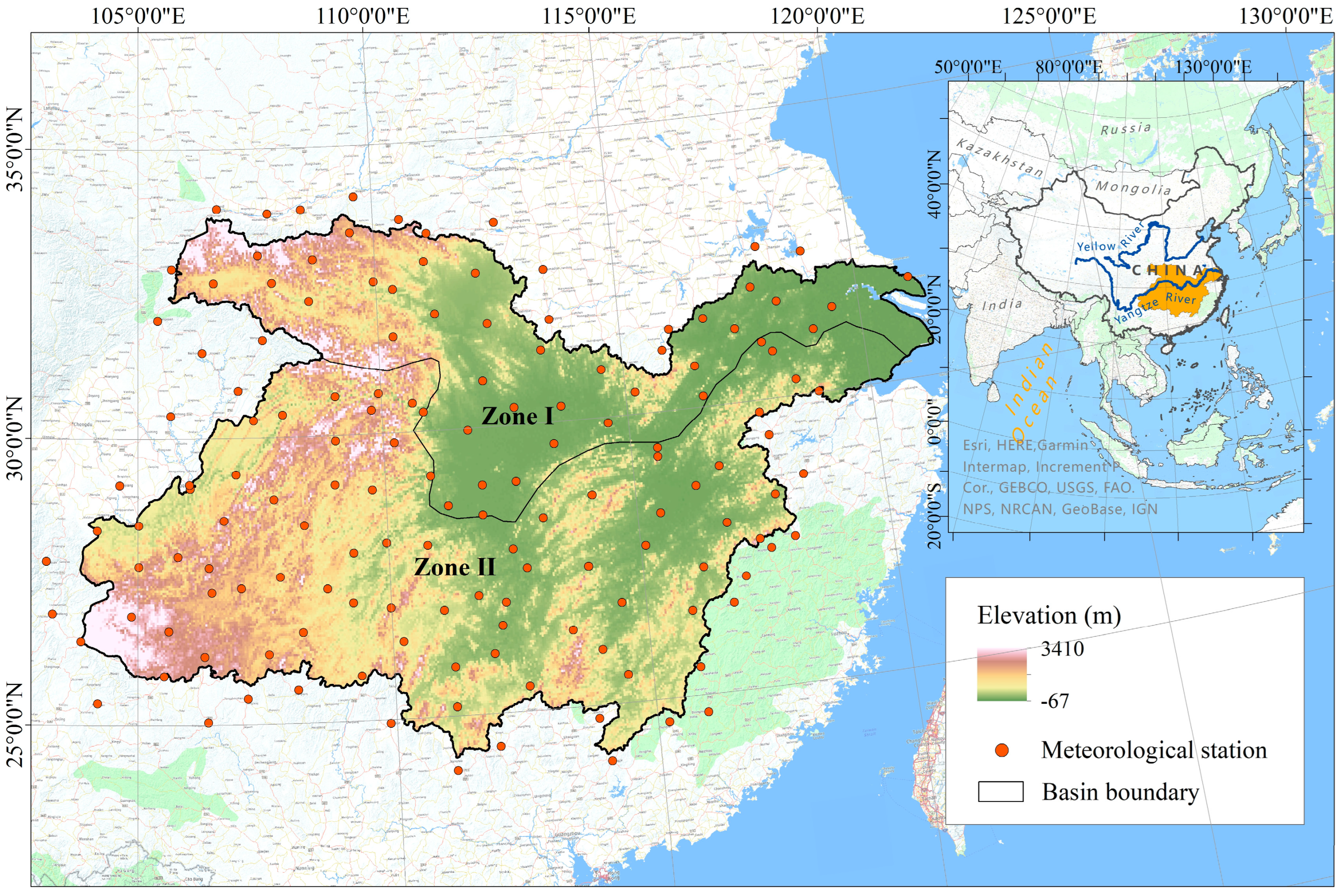

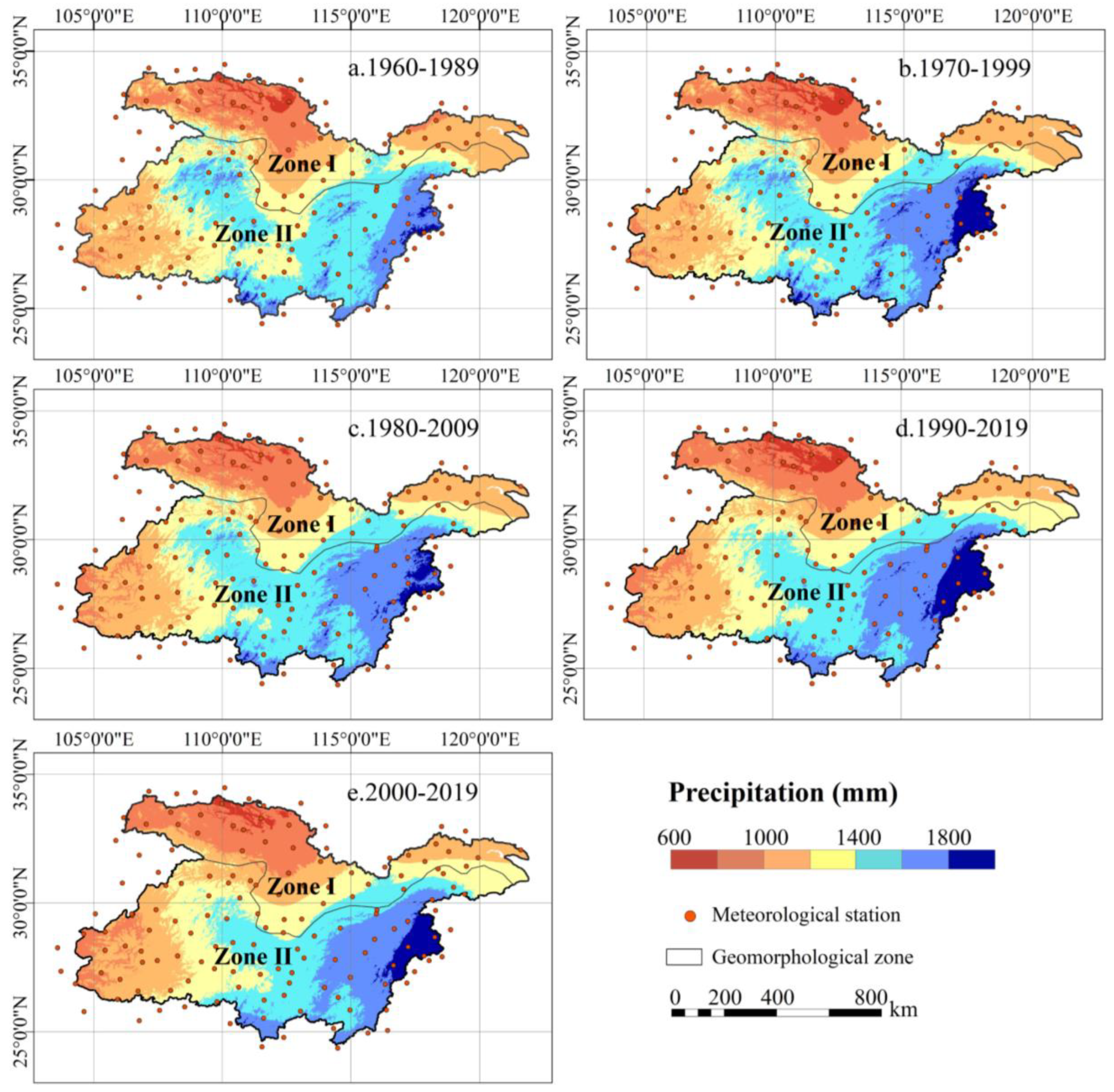
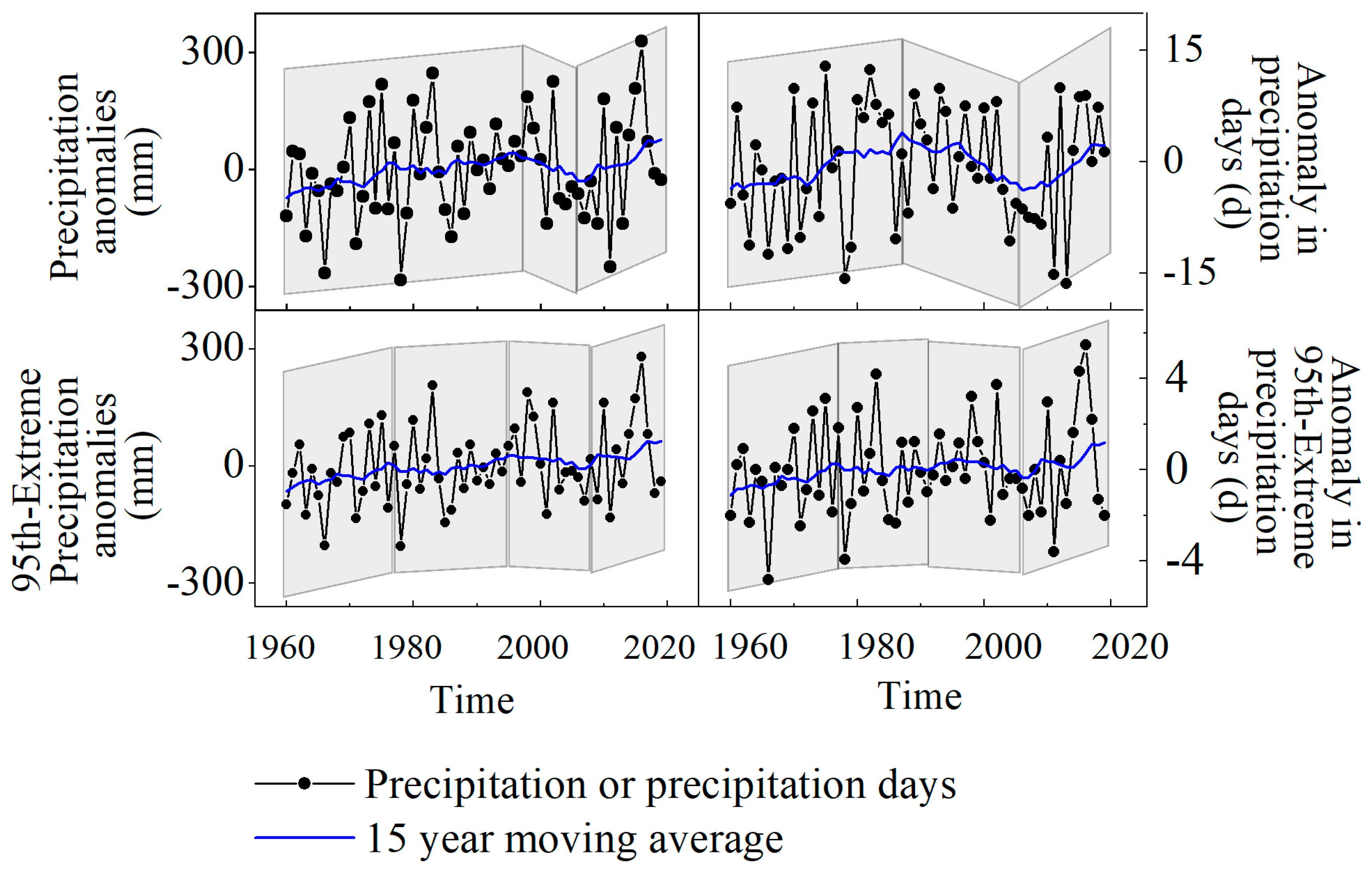
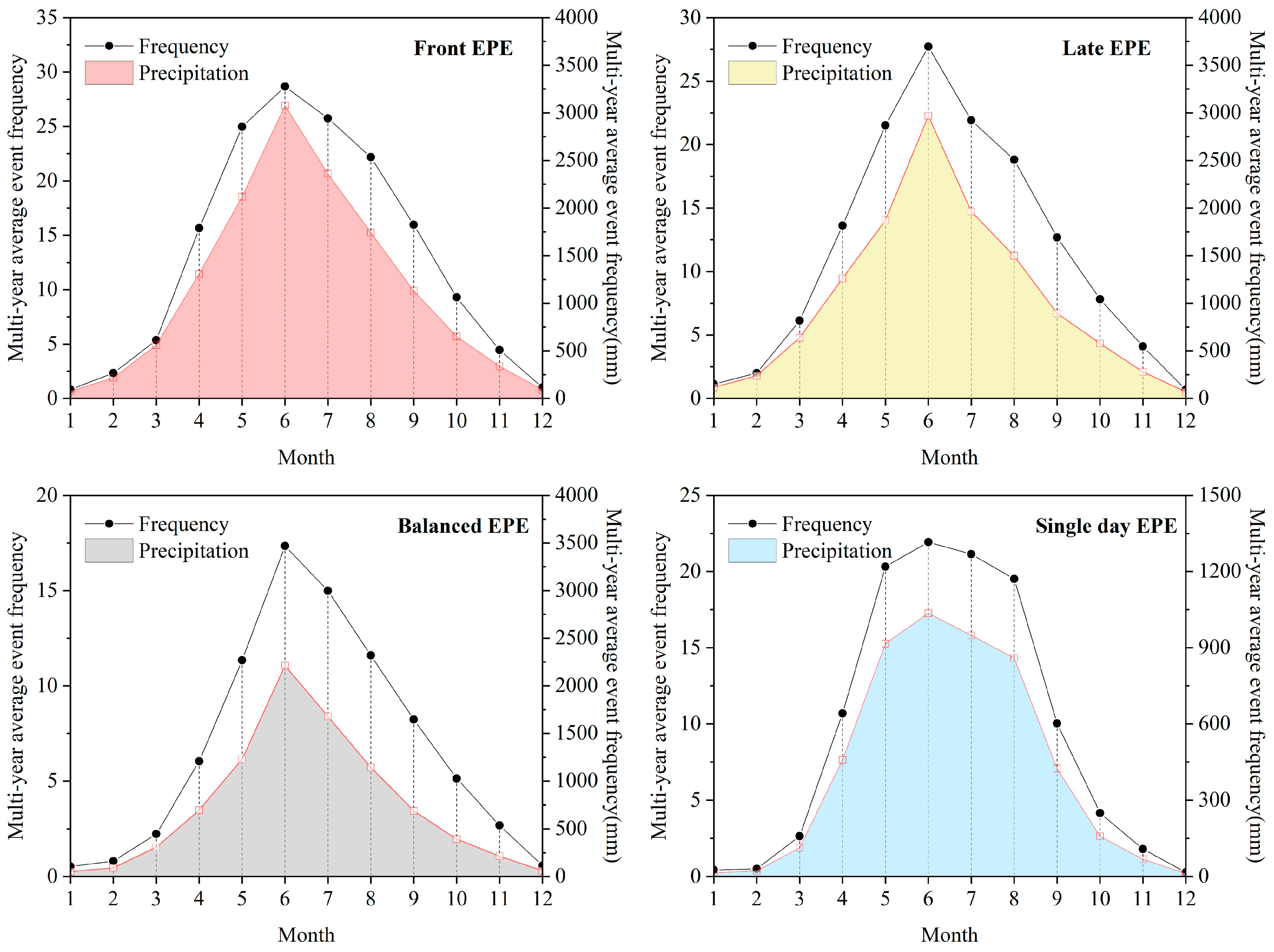
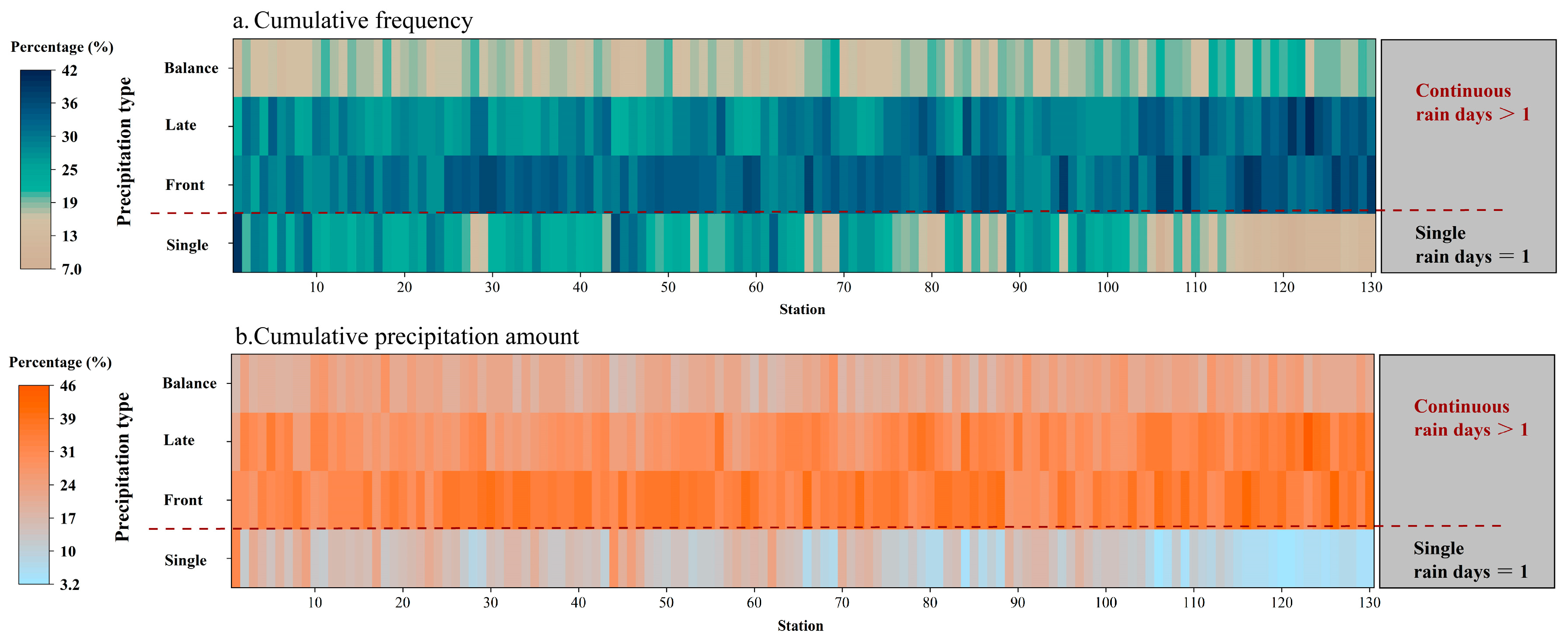
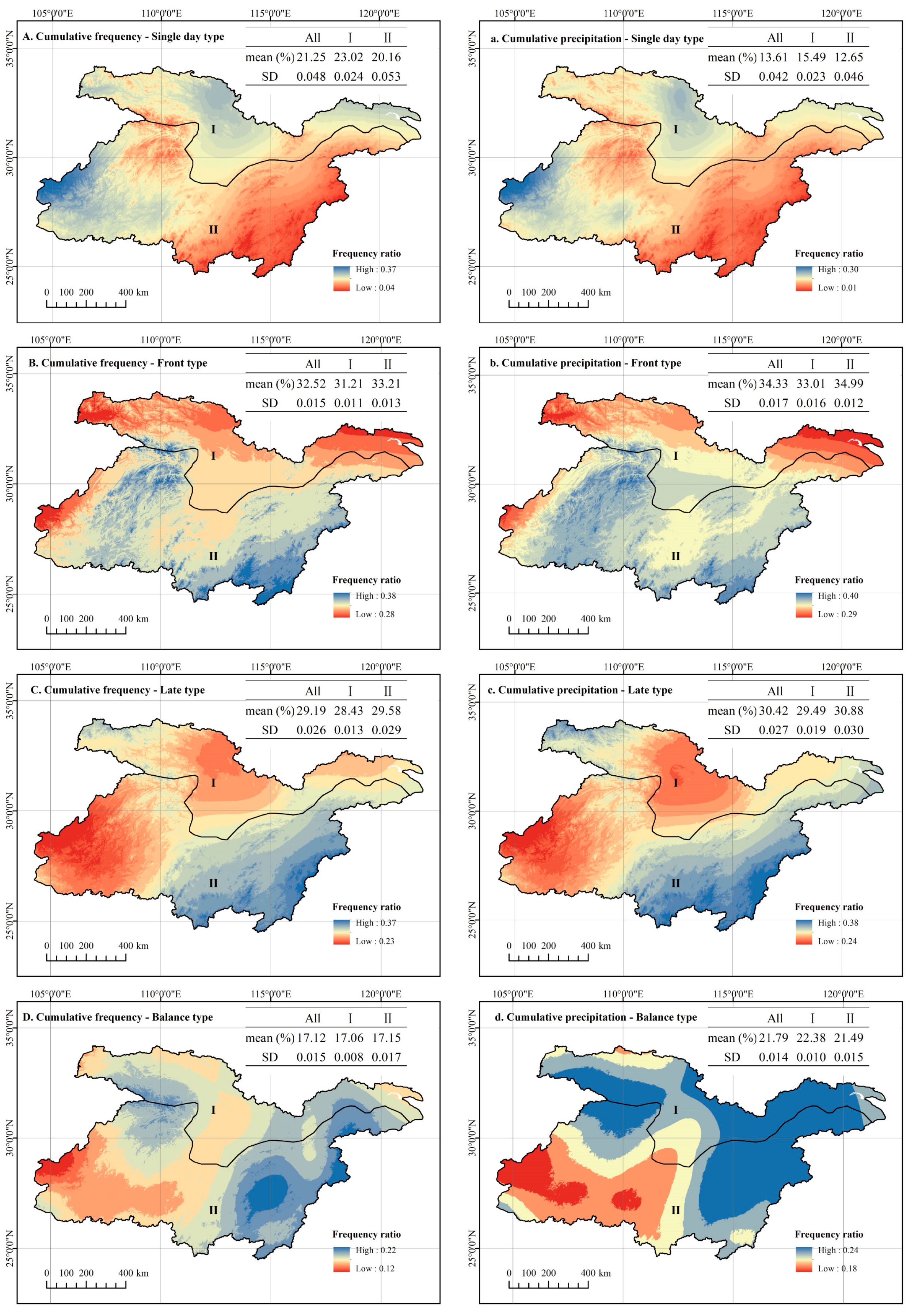

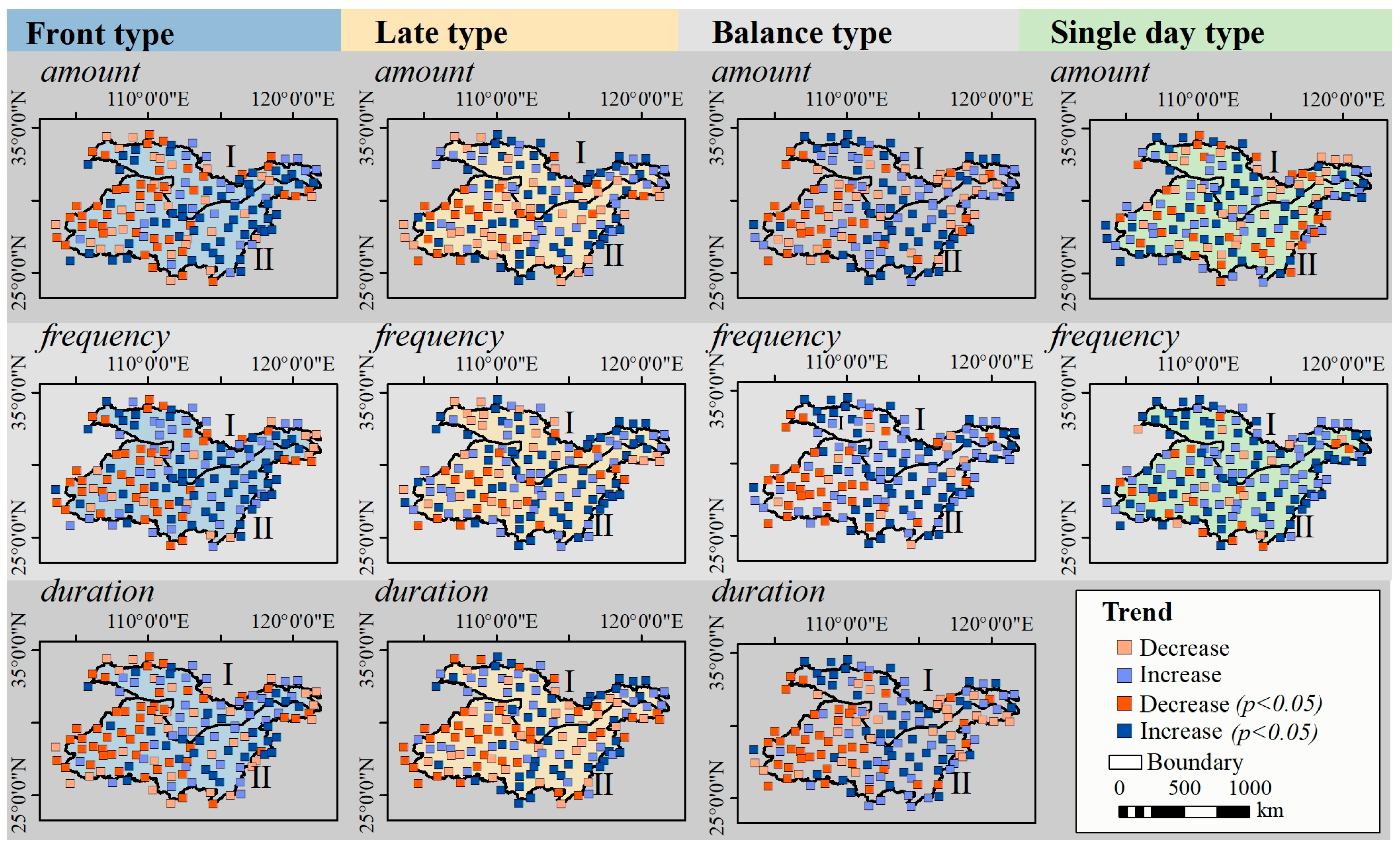
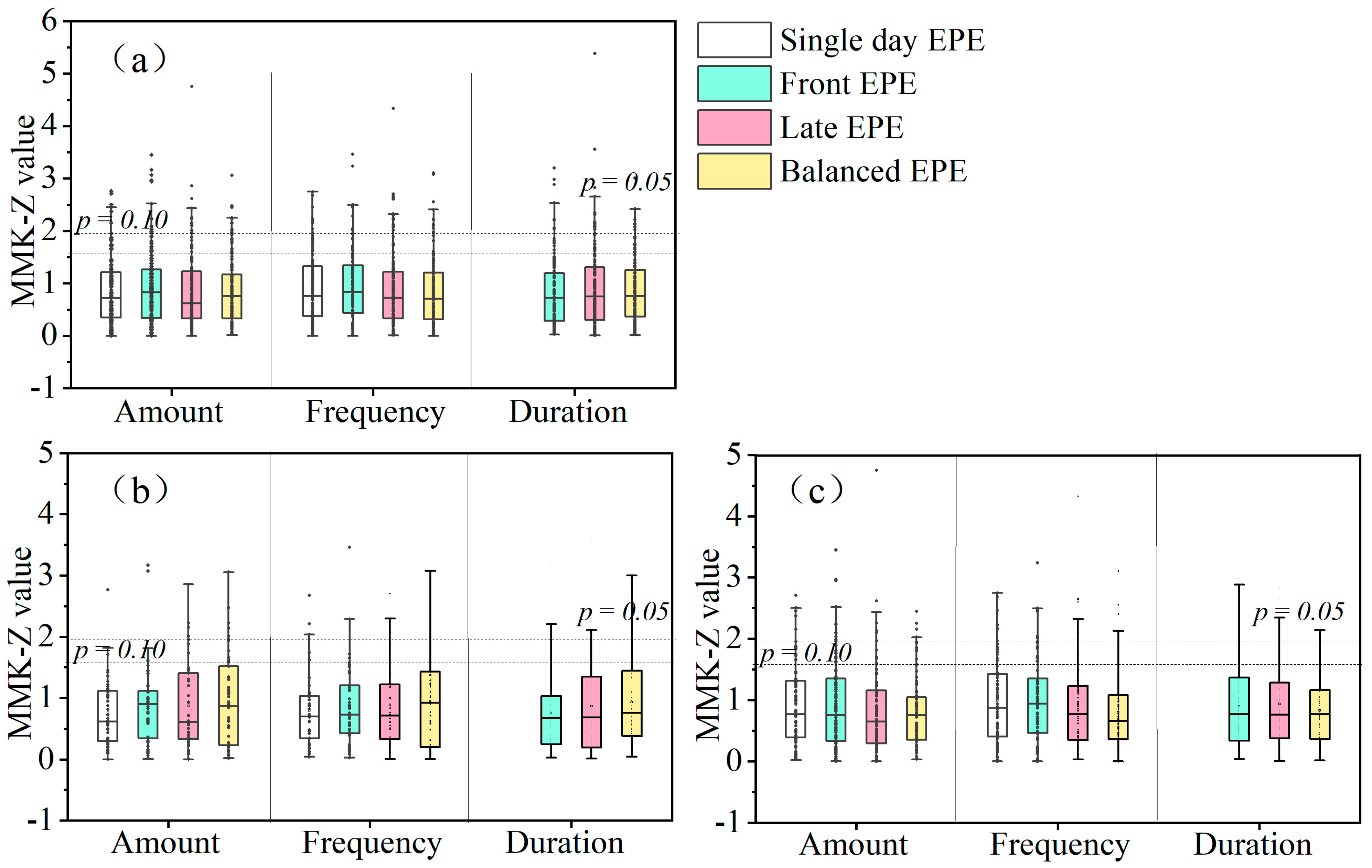
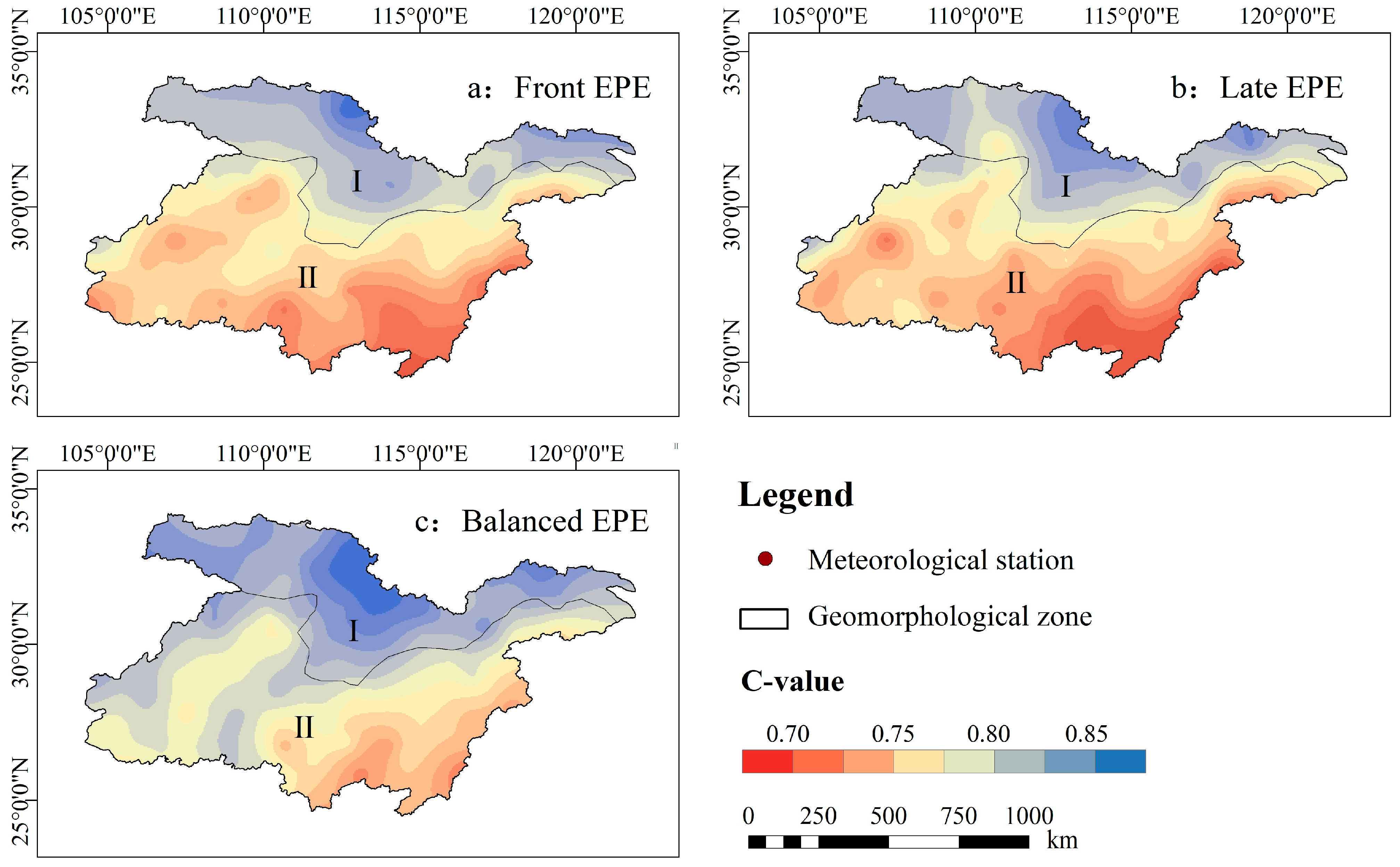
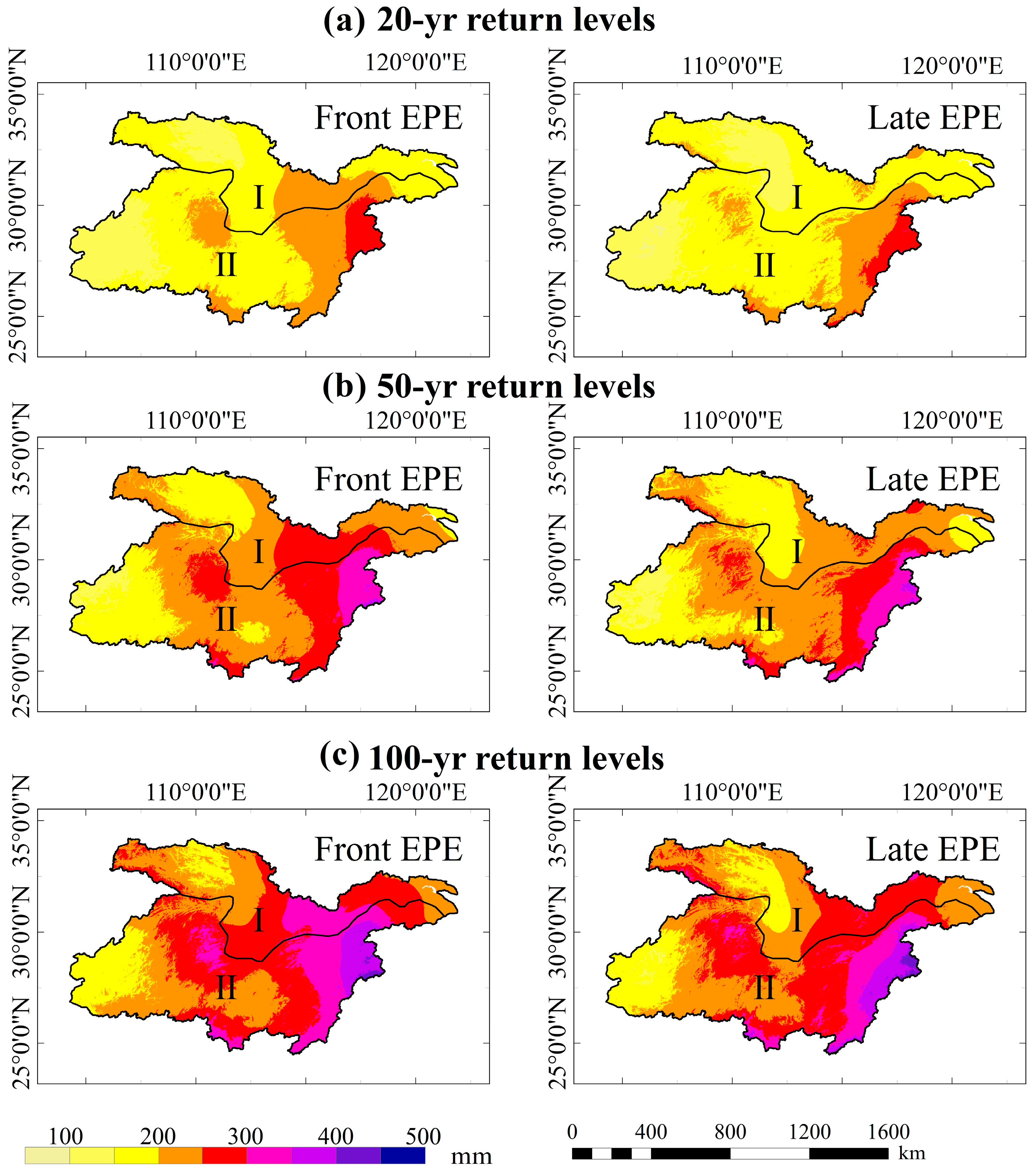

| Abbreviation | Index | Definition | Unit |
|---|---|---|---|
| Annual total wet-day precipitation | PRCPTOT | Sum of annual precipitation | mm |
| Precipitation on very extremely wet days | R99p | Sum of precipitation with daily precipitation ≥ 99th percentile | mm |
| Precipitation on extreme wet days | R95p | Sum of precipitation with daily precipitation ≥ 95th percentile | mm |
| Wet days | Rday | Sum of annual precipitation days | d |
| Total precipitation on extreme wet days | R95day | Sum of day with daily precipitation ≥ 95th percentile | d |
| Simple precipitation intensity index | SDII | Average precipitation in precipitation days | mm·d−1 |
| Simple extreme precipitation intensity index | SDIIq95 | Average precipitation in extreme precipitation days | mm·d−1 |
| Type | Categorization | Explanation |
|---|---|---|
| Single day type | A. Single day EPE | EPE occurs within only 1 day, are short period, and are of high intensity. |
| Continuous type | B. Front EPE | In an EPE, the extreme precipitation exceeding the 95.0% threshold is clustered in the first half of the total precipitation period. That is, the first period is the time when extreme precipitation occurs, and the later period has no extreme precipitation, and the intensity of precipitation is significantly weakened. |
| C. Late EPE | The distribution of the extreme precipitation moments above the 95.0% threshold for an EPE is mainly in the second half of the total course. | |
| D. Balanced EPE | Extreme precipitation exceeding the 95.0% threshold for an EPE are distributed in both the before and after phases, indicating that the precipitation process has multiple extreme peaks. |
| Element | Category | SNR | Signal | RMSE | RTVAR |
|---|---|---|---|---|---|
| Average precipitation | 1960–1989 | 0.31 | 14.2 | 14.1 | 25.3 |
| 1970–1999 | 0.18 | 11.9 | 17.3 | 30.5 | |
| 1980–2009 | 0.21 | 14.5 | 19.8 | 40.6 | |
| 1990–2019 | 0.20 | 12.7 | 20.3 | 44.7 | |
| 2000–2019 | 0.25 | 12 | 18.7 | 30.4 | |
| Cumulative EPE frequency | Front EPE | 0.15 | 8,9 | 0.0061 | 0.0199 |
| Late EPE | 0.24 | 11.5 | 0.0083 | 0.0151 | |
| Balanced EPE | 0.18 | 9.7 | 0.0075 | 0.0167 | |
| Single day EPE | 0.19 | 10.5 | 0.007 | 0.0163 | |
| Cumulative EPE volume | Front EPE | 0.17 | 10.1 | 0.0082 | 0.0179 |
| Late EPE | 0.21 | 11.3 | 0.0055 | 0.0225 | |
| Balanced EPE | 0.19 | 9.9 | 0.0088 | 0.0193 | |
| Single day EPE | 0.15 | 9.1 | 0.0067 | 0.0221 |
| PRCPTOT (mm) | a. 1960–1989 | b. 1970–1999 | c. 1980–2009 | d. 1990–2019 | e. 2000–2019 | |||||
|---|---|---|---|---|---|---|---|---|---|---|
| Area Ratio (%) | Change Ratio (%) | Area Ratio (%) | Change Rate (a,b) (%) | Area Ratio (%) | Change Rate (a–c) (%) | Area Ratio (%) | Change Rate (a–d) (%) | Area Ratio (%) | Change Rate (a–e) (%) | |
| 600–800 | 1.9 | / | 2.4 | 26.3 | 1.1 | −42.1 | 2.9 | 52.6 | 1.5 | −21.1 |
| 800–1000 | 11.4 | / | 11.0 | −3.5 | 13.4 | 17.5 | 14.0 | 22.8 | 15.9 | 39.5 |
| 1000–1200 | 22.7 | / | 21.2 | −6.6 | 21.3 | −6.2 | 21.0 | −7.5 | 22.3 | −1.8 |
| 1200–1400 | 25.8 | / | 19.7 | −23.6 | 20.4 | −20.9 | 19.5 | −24.4 | 22.0 | −14.7 |
| 1400–1600 | 27.1 | / | 26.1 | −3.7 | 26.8 | −1.1 | 21.7 | −19.9 | 20.9 | −22.9 |
| 1600–1800 | 10.0 | / | 15.7 | 57.0 | 15.0 | 50.0 | 16.1 | 61.0 | 14.4 | 44.0 |
| >1800 | 1.0 | / | 3.8 | 280.0 | 2.0 | 100.0 | 4.7 | 370.0 | 3.1 | 210.0 |
| Index | 1960–1989 (30a) | 1970–1999 (30a) | 1980–2009 (30a) | 1990–2019 (30a) | 2000–2019 (20a) | 1960–2019 (60a) | ||||||
|---|---|---|---|---|---|---|---|---|---|---|---|---|
| Slope | Mean | Slope | Mean | Slope | Mean | Slope | Mean | Slope | Mean | Slope | Mean | |
| PRCPTOT | 2.023 | 1286.71 | 3.654 | 1324.73 | −4.551 * | 1318.52 | −0.432 | 1328.15 | 4.994 | 1312.53 | 1.26 | 1307.39 |
| R99p | 0.956 | 47.22 | 2.437 * | 48.21 | −0.02 | 48.33 | 1.124 | 48.92 | 2.966 | 48.64 | 0.98 ** | 48.11 |
| R95p | 1.861 | 19.81 | 3.173 * | 20.22 | −0.035 | 20.10 | 0.713 | 20.37 | 4.668 | 20.17 | 1.393 ** | 20.01 |
| Rday | 0.252 ** | 103.30 | −0.018 | 105.40 | −0.557 *** | 104.71 | −0.187 | 103.72 | 0.163 | 102.65 | 0.026 | 103.52 |
| P95day | 0.024 | 18.34 | 0.043 | 18.88 | −0.033 | 18.72 | 0.018 | 18.92 | 0.063 | 18.83 | 0.014 * | 18.64 |
| SDII | 0.006 | 12.46 | 0.012 * | 12.60 | −0.009 | 12.59 | −0.001 | 12.81 | 0.016 | 12.79 | 0.005 * | 12.63 |
| SDIIq95 | 0.024 | 1.07 | 0.093 ** | 1.07 | 0.032 | 1.075 | 0.061 * | 1.074 | 0.098 ** | 1.069 | 0.036 *** | 1.075 |
| EPE Type | Index | I-North Area | II-South Area | Total Area | |||
|---|---|---|---|---|---|---|---|
| Correlation Coefficient | Sig | Correlation Coefficient | Sig | Correlation Coefficient | Sig | ||
| Front EPE | Precipitation | −0.15 | 0.87 | 0.07 | 0.98 | 0.10 | 0.71 |
| Day | −0.21 | 0.57 | 0.10 | 0.45 | 0.15 | 0.55 | |
| Frequency | −0.15 | 0.87 | 0.10 | 0.95 | 0.02 | 0.64 | |
| Late EPE | Precipitation | 0.25 | 0.99 | 0.25 | 0.99 | 0.20 | 0.99 |
| Day | 0.35 | 0.68 | 0.43 | 0.98 | 0.39 | 0.95 | |
| Frequency | 0.18 | 0.98 | 0.20 | 0.99 | 0.19 | 0.98 | |
| Balance EPE | Precipitation | 0.11 | 0.43 | 0.23 | 0.88 | 0.17 | 0.68 |
| Day | 0.31 | 0.33 | 0.13 | 0.89 | 0.28 | 0.76 | |
| Frequency | 0.08 | 0.50 | 0.19 | 0.42 | 0.14 | 0.44 | |
| Single day EPE | Precipitation | 0.44 | 1 | 0.49 | 0.99 | 0.46 | 0.99 |
| Day | 0.31 | 0.99 | 0.41 | 0.99 | 0.37 | 0.99 | |
Disclaimer/Publisher’s Note: The statements, opinions and data contained in all publications are solely those of the individual author(s) and contributor(s) and not of MDPI and/or the editor(s). MDPI and/or the editor(s) disclaim responsibility for any injury to people or property resulting from any ideas, methods, instructions or products referred to in the content. |
© 2024 by the authors. Licensee MDPI, Basel, Switzerland. This article is an open access article distributed under the terms and conditions of the Creative Commons Attribution (CC BY) license (https://creativecommons.org/licenses/by/4.0/).
Share and Cite
Zhang, Y.; Li, P.; Xu, G.; Li, Z.; Wang, Z.; Rao, Y.; Liu, Z.; Chen, Y.; Wang, B. Spatiotemporal Variation Characteristics of Extreme Precipitation in the Mid–Lower Reaches of the Yangtze River Basin Based on Precipitation Events. Sustainability 2024, 16, 9197. https://doi.org/10.3390/su16219197
Zhang Y, Li P, Xu G, Li Z, Wang Z, Rao Y, Liu Z, Chen Y, Wang B. Spatiotemporal Variation Characteristics of Extreme Precipitation in the Mid–Lower Reaches of the Yangtze River Basin Based on Precipitation Events. Sustainability. 2024; 16(21):9197. https://doi.org/10.3390/su16219197
Chicago/Turabian StyleZhang, Yixin, Peng Li, Guoce Xu, Zhanbin Li, Zhou Wang, Yueming Rao, Zifan Liu, Yiting Chen, and Bin Wang. 2024. "Spatiotemporal Variation Characteristics of Extreme Precipitation in the Mid–Lower Reaches of the Yangtze River Basin Based on Precipitation Events" Sustainability 16, no. 21: 9197. https://doi.org/10.3390/su16219197
APA StyleZhang, Y., Li, P., Xu, G., Li, Z., Wang, Z., Rao, Y., Liu, Z., Chen, Y., & Wang, B. (2024). Spatiotemporal Variation Characteristics of Extreme Precipitation in the Mid–Lower Reaches of the Yangtze River Basin Based on Precipitation Events. Sustainability, 16(21), 9197. https://doi.org/10.3390/su16219197








